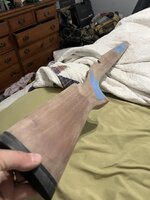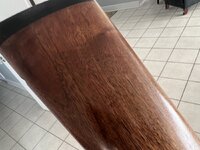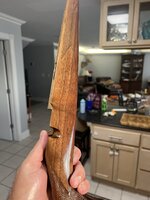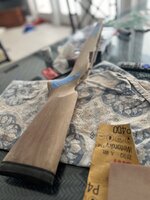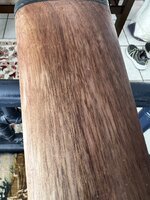Navigation
Install the app
How to install the app on iOS
Follow along with the video below to see how to install our site as a web app on your home screen.
Note: This feature may not be available in some browsers.
More options
Style variation
You are using an out of date browser. It may not display this or other websites correctly.
You should upgrade or use an alternative browser.
You should upgrade or use an alternative browser.
Rifles stock refinishing / recoil pad question. A-Bolt II
- Thread starter Panhandler80
- Start date
There’s a lot of ways to stain, but if you can start finishing with a plan thats easiest. Once you are sanded, wet it down with water to saise the grain and sand again, but while wet you should get a sense of the color—it’ll be a little darker when freshly wet with water on it than it will be when finished. If it looks good and evenly colored, probably no need.
Refinishing stocks that had a different stain on them previously, what I found works best is actually to put several coats of plain finish on the stock and let it fully cure. At that point you’ll be able to see if there are weird color splotches or patches left over from the previous stain, or from some of the previous finish left in the surface of the wood, or if there is sap-wood in the stock that needs colored to match. If it looks great, just finish with your topcoats and you’re done. But if you decide to stain, then you can cut it back to wood using water as a sanding lubricant, apply the stain or dye on the bare but filled wood, and then topcoat over that. It’s a bit more work to apply a stain this way, but on fairly open pored wood like you typically find on factory stocks, I think you wind up with a better color than if you used a stain right on the un-sealed wood.
Refinishing stocks that had a different stain on them previously, what I found works best is actually to put several coats of plain finish on the stock and let it fully cure. At that point you’ll be able to see if there are weird color splotches or patches left over from the previous stain, or from some of the previous finish left in the surface of the wood, or if there is sap-wood in the stock that needs colored to match. If it looks great, just finish with your topcoats and you’re done. But if you decide to stain, then you can cut it back to wood using water as a sanding lubricant, apply the stain or dye on the bare but filled wood, and then topcoat over that. It’s a bit more work to apply a stain this way, but on fairly open pored wood like you typically find on factory stocks, I think you wind up with a better color than if you used a stain right on the un-sealed wood.
Panhandler80
WKR
HuntHarder
WKR
Tru oil
Panhandler80
WKR
Panhandler80
WKR
And that’s just mineral spirits on the wood. It’s a lot better as I really finish it with a wall oil and then some buffing and maybe a wax.
Panhandler80
WKR
And that’s just mineral spirits on the wood. It’s a lot better as I really finish it with a wall oil and then some buffing and maybe a
Similar threads
- Replies
- 17
- Views
- 830
- Replies
- 5
- Views
- 526
- Replies
- 35
- Views
- 6K
Featured Video
Latest Articles
- TT#64 Josh Boyd Elk Hunting Strategies for Every Season
- Aaron Davidson of Gunwerks
- TT#63 Dirk Durham’s Art of Elk Calling
- BIG Buck Stories with the Dirty Giants Podcast
- TT#62 Brian Barney Hunting Bulls without Calling
- Hoyt Alpha AX-2 SD Review
- Kuiu Kenai vs Outdoor Vitals Vario Hooded Jacket Review
- Hoyt RX-9 Ultra Review
- Hunting Vampire Bucks & Building an Optics Kit
- Darton Sequel ST2 35 Review


